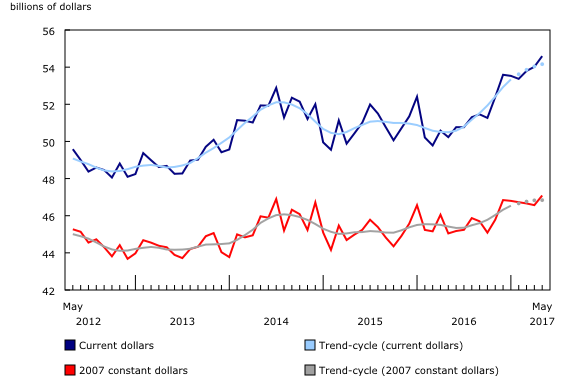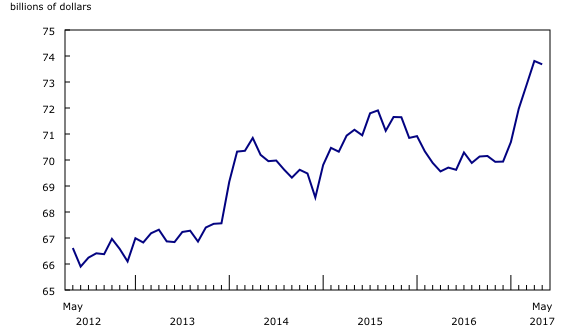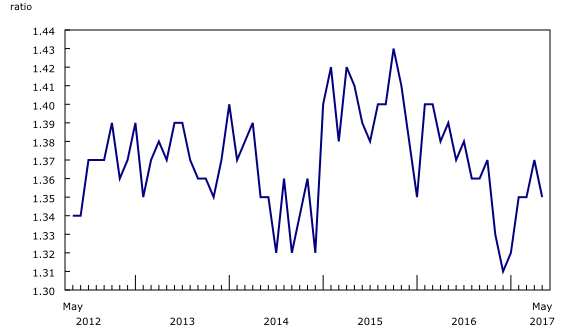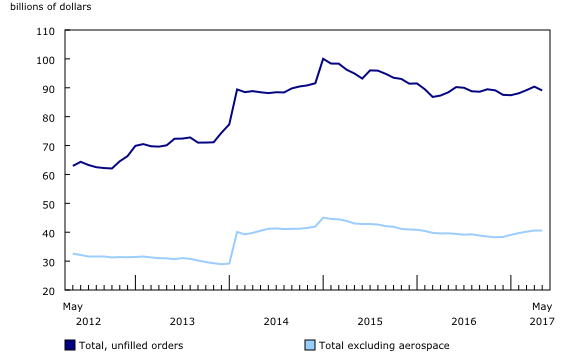Monthly Survey of Manufacturing, May 2017
Archived Content
Information identified as archived is provided for reference, research or recordkeeping purposes. It is not subject to the Government of Canada Web Standards and has not been altered or updated since it was archived. Please "contact us" to request a format other than those available.
Released: 2017-07-19
Manufacturing sales increased for the third consecutive month, up 1.1% to $54.6 billion in May. The gain was mainly attributable to higher sales in the transportation equipment and chemical manufacturing industries.
Sales were up in 16 of 21 industries, representing 71% of the manufacturing sector. Sales of durable goods rose 2.2%, while sales of non-durable goods declined 0.3%.
In constant dollars, sales were up 1.1%, indicating that higher volumes of manufactured goods were sold in May.
Transportation equipment and chemical sales lead the gains
Sales in the transportation equipment industry rose 4.2% to $11.5 billion in May, the third gain in four months. The growth was the result of increases in the motor vehicle (+8.6%) and the motor vehicle parts (+5.7%) industries, mainly reflecting higher volumes. After removing the effect of price changes, sales in volume terms rose 8.1% and 5.0% respectively in these industries in May.
Chemical manufacturing sales increased 2.4% to $4.4 billion, following three months of declines. The gain was widespread among all seven chemical manufacturing industries. However, the pesticide, fertilizer and the other agricultural chemical manufacturing industries posted the largest sales increase. Generally, sales spike in these industries once seeding in the agricultural sector has taken place.
In constant dollars, sales in the chemical industry were up 1.5%, indicating higher volumes of chemical products were sold.
These increases were partially offset by a 3.4% decline in the petroleum and coal product industry to $5.0 billion, mostly reflecting lower prices. After removing the effect of price changes, sales volumes of petroleum and coal products rose 0.7% in May.
Sales up in six provinces, led by Ontario
Sales increased in six provinces in May, led by Ontario.
Sales in Ontario increased 2.6% to $26.3 billion in May, their highest value on record. Growth in May was largely attributable to the motor vehicle (+8.7%) and motor vehicle parts (+5.8%) industries. These increases were partially offset by lower petroleum and coal product sales (-6.6%).
In Alberta, sales rose 1.3% to $6.1 billion, the seventh consecutive monthly increase. Sales were up in 11 of 21 industries, largely driven by gains in the chemical (+8.9%) industry and, to a lesser extent, the machinery industry.
Sales in Quebec fell 1.8% to $12.7 billion in May, following a 2.3% increase in April. The decline was mostly attributable to lower production in the aerospace product and parts industry and lower sales in the food industry. These decreases were partly offset by higher sales in the paper, wood product, and plastics and rubber products industries.
Inventory levels edge down
Manufacturing inventory levels edged down 0.2% to $73.7 billion in May, following five months of gains.
Inventories fell in 8 of the 21 industries, with the aerospace products and parts (-2.6%) and the chemical (-2.0%) industries recording the largest declines. These decreases were partially offset by a 1.8% increase in primary metal inventories.
The inventory-to-sales ratio declined from 1.37 in April to 1.35 in May. This ratio measures the time, in months, that would be required to exhaust inventories if sales were to remain at their current level.
Unfilled orders decline
Unfilled orders fell 1.5% to $89.1 billion in May, following three months of gains. Most of the decrease was attributable to a drop in unfilled orders in the aerospace products and parts industry.
These declines were partially offset by an increase in unfilled orders in the fabricated metal product and machinery industries.
New orders declined 3.6% to $53.3 billion in May, following five months of gains. The decrease mostly reflected lower new orders in the aerospace product and parts industry. These declines were partially offset by higher new orders in the motor vehicle and motor vehicle parts industries.

In celebration of the country's 150th birthday, Statistics Canada is presenting snapshots from our rich statistical history.
Commercial beer manufacturing
The history of commercial beer brewing pre-dates Confederation by almost 200 years. In 1668, Canada's first commercial brewery was built in Québec by Jean Talon, the first Intendant of New France. By 2016, with the recent increase of micro-brewing, the industry has grown to 775 breweries nationally.
In 1917, despite alcohol prohibition in multiple provinces, Canadian commercial brewers of beer, ale, stout, and porter produced just over 101.4 million litres of output valued at $15.4 million. By 1967, output of Canadian breweries had increased to over 1.2 billion litres, valued at $335.6 million. In 2016, commercial Canadian beer manufacturers produced over 2.2 billion litres, and breweries reported sales of over $5.4 billion.
Note to readers
Monthly data in this release are seasonally adjusted and are expressed in current dollars unless otherwise specified. For information on seasonal adjustment, see Seasonally adjusted data – Frequently asked questions.
For information on trend-cycle data, see Trend-cycle estimates – Frequently asked questions.
Non-durable goods industries include food, beverage and tobacco products, textile mills, textile product mills, clothing, leather and allied products, paper, printing and related support activities, petroleum and coal products, chemicals, and plastics and rubber products.
Durable goods industries include wood products, non-metallic mineral products, primary metals, fabricated metal products, machinery, computer and electronic products, electrical equipment, appliances and components, transportation equipment, furniture and related products, and miscellaneous manufacturing.
Production-based industries
For the aerospace and shipbuilding industries, the value of production is used instead of the value of sales of goods manufactured. The value of production is calculated by adjusting monthly sales of goods manufactured by the monthly change in inventories of goods in process and finished products manufactured. The value of production is used because of the extended period of time that it normally takes to manufacture products in these industries.
Unfilled orders are a stock of orders that will contribute to future sales assuming that the orders are not cancelled.
New orders are those received, whether sold in the current month or not. New orders are measured as the sum of sales for the current month plus the change in unfilled orders from the previous month to the current month.
Manufacturers reporting in US dollars
Some Canadian manufacturers report sales, inventories and unfilled orders in US dollars. These data are then converted to Canadian dollars as part of the data production cycle.
For sales, based on the assumption that they occur throughout the month, the average monthly exchange rate for the reference month (noon spot rate) established by the Bank of Canada is used for the conversion. The monthly average exchange rate is available in CANSIM table 176-0081. Inventories and unfilled orders are reported at the end of the reference period. For most respondents, the noon spot exchange rate on the last working day of the month is used for the conversion of these variables.
However, some manufacturers choose to report their data as of a day other than the last day of the month. In these instances, the noon spot exchange rate on the day selected by the respondent is used. Note that because of exchange rate fluctuations, the noon spot exchange rate on the day selected by the respondent can differ from both the exchange rate on the last working day of the month and the monthly average exchange rate. Noon spot exchange rate data are available in CANSIM table 176-0080.
Revision policy
Each month, the Monthly Survey of Manufacturing releases preliminary data for the reference month and revised data for the three previous months. Revisions are made to reflect new information provided by respondents and updates to administrative data. Once a year, a revision project is undertaken to revise multiple years of data. During annual revisions, changes are made to seasonal adjustment parameters.
Real-time CANSIM tables
Real-time CANSIM tables 304-8014, 304-8015 and 377-8009 will be updated on July 31. For more information, consult the document Real-time CANSIM tables.
Next release
Data from the Monthly Survey of Manufacturing for June will be released on August 17.
Contact information
For more information, contact us (toll-free 1-800-263-1136; 514-283-8300; STATCAN.infostats-infostats.STATCAN@canada.ca) or Media Relations (613-951-4636; STATCAN.mediahotline-ligneinfomedias.STATCAN@canada.ca).
To enquire about the concepts, methods or data quality of this release, contact Bechir Oueriemmi (613-951-7938; bechir.oueriemmi@canada.ca), Manufacturing and Wholesale Trade Division.
- Date modified:







